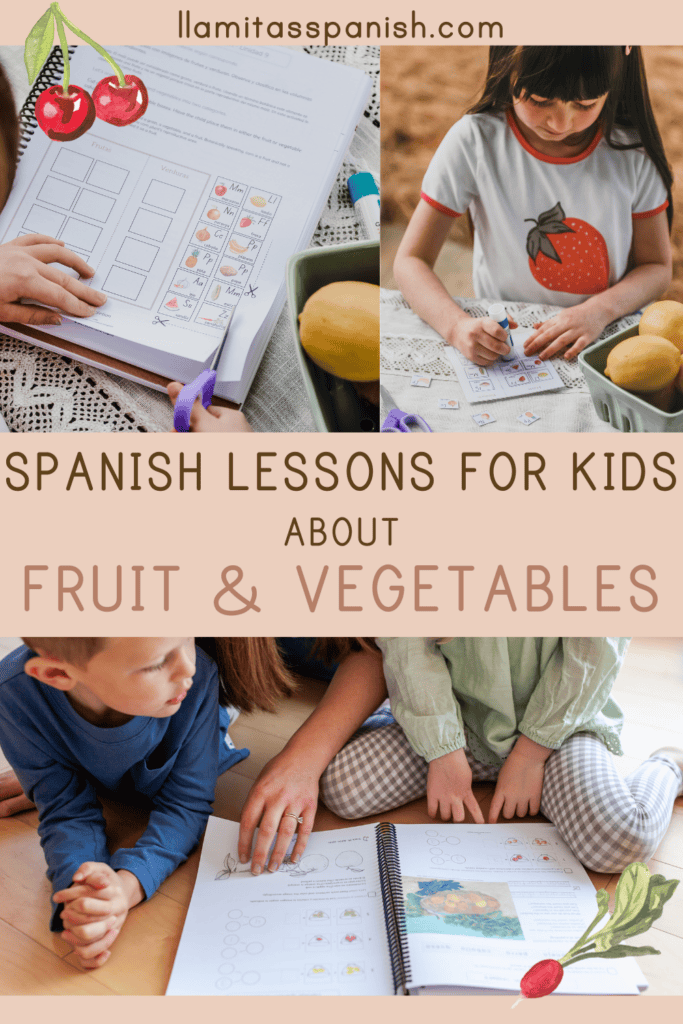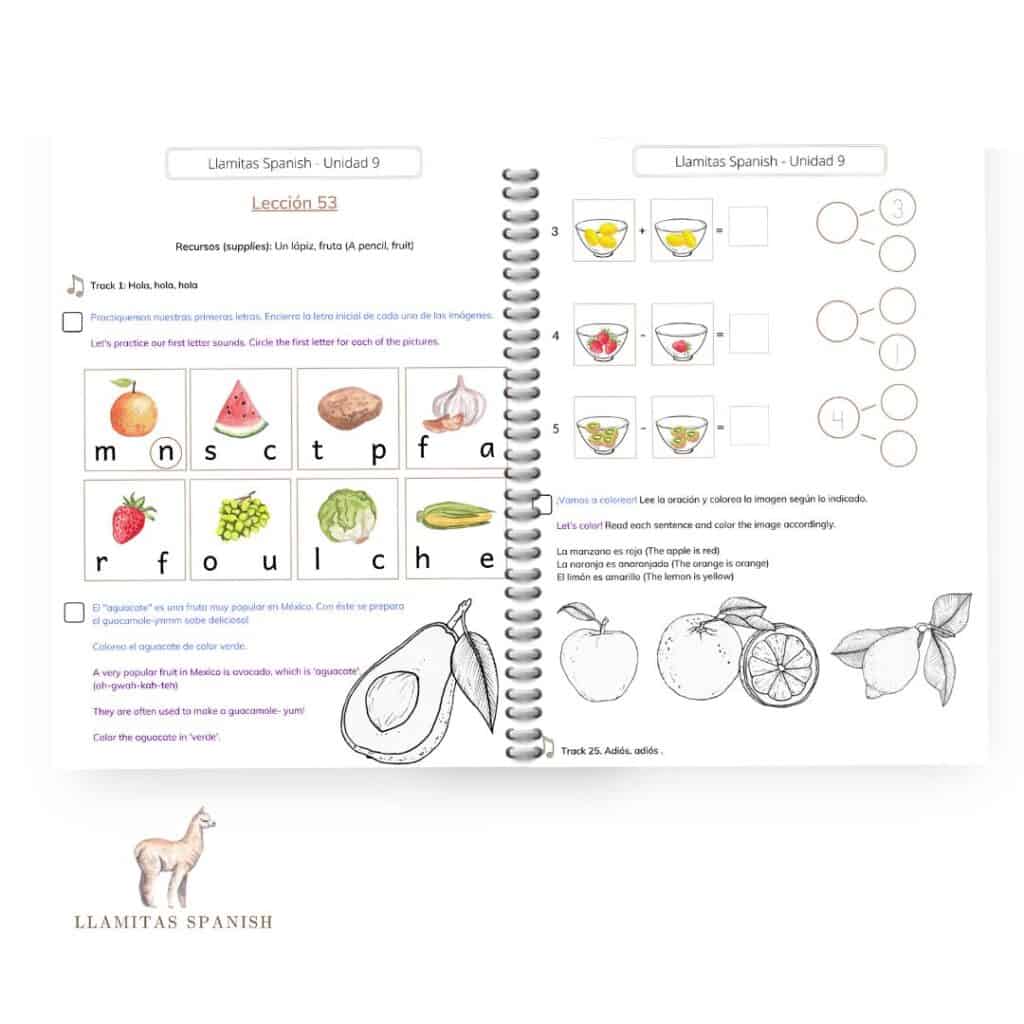In this post: Make the most of the resources in today’s post to learn all about fruit and vegetables in Spanish.
When it comes to fruit and vegetables, some kids hate them while others love them. Sometimes it even depends on the mood they’re in on a particular day.
So while it’s important to start good habits for healthy eating at a young age, it can certainly be a battle. One way to make it easier is to make it fun!

This post contains affiliate links.
The same goes for learning Spanish. Making it fun goes a long way. You can do that by using the thematic learning model which is more interactive, meaningful and engaging when compared to other traditional methods of teaching.
Using a thematic approach, today’s post explores the topic of fruit and vegetables and gives you a number of resources your kids will enjoy as they continue along the road to bilingualism.
Table of Contents
Fruit and Vegetables Vocabulary in Spanish
Learn the words for some of the most common fruit and vegetables in Spanish. The next time your kids help out in the kitchen, they should be able to recall some of the following:
| Spanish | English |
| manzana | apple |
| naranja | orange |
| fresa | strawberry |
| limón | lemon |
| plátanos | plantains |
| kiwi | kiwi |
| ajo | garlic |
| sandía | watermelon |
| lechuga | lettuce |
| elote | corn |
| uvas | grapes |
| zanahoria | carrot |
| brócoli | broccoli |
| tomate | tomato |
| calabaza | pumpkin |
| pera | pear |
| durazno | peach |
| cebolla | onion |
| papa/patata | potato |
| espinaca | spinach |
| pepino | cucumber |
| piña | pineapple |
Incorporate these words into a game with your kids by giving each person a chance to describe a fruit or vegetable that other players have to guess in Spanish. This will be a great activity to review colors and shapes as well as adjectives such as grande, pequeño, redondo, largo and more.
Las frutas y las verduras: Spanish Lessons
Earlier we mentioned making lessons fun. That’s one reason why we include a wide variety of activities in our Level 1 curriculum. Through counting, singing, coloring and art, your kids will be able to name fruit and vegetables, learn about the letter Kk de kiwi and much more.

We’ve also included some fun crafts and additional printables for practicing tracing and phonics.
Spanish Books about Fruit and Vegetables
Read aloud and put those Spanish phonics lessons to use while delving into the topic of fruit and vegetables with the following book recommendations:
Comiendo el Arcoíris by Patricia Barrera Boyer

A great bilingual story for picky eaters! A grandmother gently introduces her granddaughter to the many colorful fruit and vegetables, so she can eat a rainbow!
¡Bebé, vamos a comer! by Stephan Lomp

Fantastic for toddlers! These ‘indestructible’ books are literally toddler-proof. The pages are made so they cannot rip. Learn about all the many colors of fruit and vegetables.
El huerto de Pico el erizo by Laurence Jammes

An interactive book with tabs to pull and slide. Learn about the process of planting and growing vegetables in your garden with Pico the hedgehog.
Limón by Antonio Rubio

A simple yet engaging rhyming book about lemons! This book is great to sing to with a repetitive and catchy rhythm. ‘Limón, limón, limón (…) limón, ¡sorpresa!’
¡Qué divertido es comer fruta! by María Teresa Barahona

Join two sisters in the south of Spain as they discover the wonder and joy of eating fruits. This award-winning book just might become one of your favorites!
Contando Fruta con Abuelita by Lilia V. Guerrero

Rooted in Latinx culture, this bright and beautifully illustrated book is great for children between 0 and 6 years old to learn about fruit while counting.
La oruga muy hambrienta by Eric Carle

Enjoy this classic, ‘The Very Hungry Caterpillar’ in Spanish! The board book is ideal for young Spanish learners.
Viaja al corazón de las frutas y las verduras by Paola Cóser

This book takes you on the ultimate adventure! In just 4 stories, you’d develop a healthy relationship with food and be more conscious of caring for the environment.
Spanish Songs about Fruit and Vegetables
The lyrics and pace of this song may be a bit challenging for beginners but this also makes it a good pick for practicing pronunciation while learning new words. Try to sing along as the verses repeat and you’ll soon get the hang of it!
2. ¿Te gusta el helado de brócoli?
Perhaps you like broccoli but what about broccoli ice cream? Yuck! Learn to talk about foods you like and dislike with the unlikely combinations in this song by Super Simple Español.
Grab your air guitar to dance and sing along to this educational song about the many uses and benefits of various fruit.
Enjoy these colorful fruit and vegetable displays while learning. You can even try recreating them at home to promote healthy habits.
Follow along with the colorful animations and learn more about describing some common fruit and vegetables in Spanish.
Spanish Curriculum for the Early Years
Now let’s go more in-depth into all that our Level 1 curriculum offers. It’s an open-and-go program that you can facilitate at home using all the resources provided which include bilingual scripts, native speaker audio, Montessori cards, a book menu, audio playlists and lots more.

The entire program consists of 12 thematic units that promote learning in 5 main areas:
- Phonemic Awareness
- Early math: Counting & Classifying
- Emergent Literacy
- Listening Comprehensions
- Fine Motor Skills and Art
- Gross Motor Skills
Related post: Should Your Kids be Learning Phonics in English and Spanish at the Same Time?
After setting up your account, you get immediate access to the program which means you can start as early as today!
Head over to our curriculum shop to enroll.
